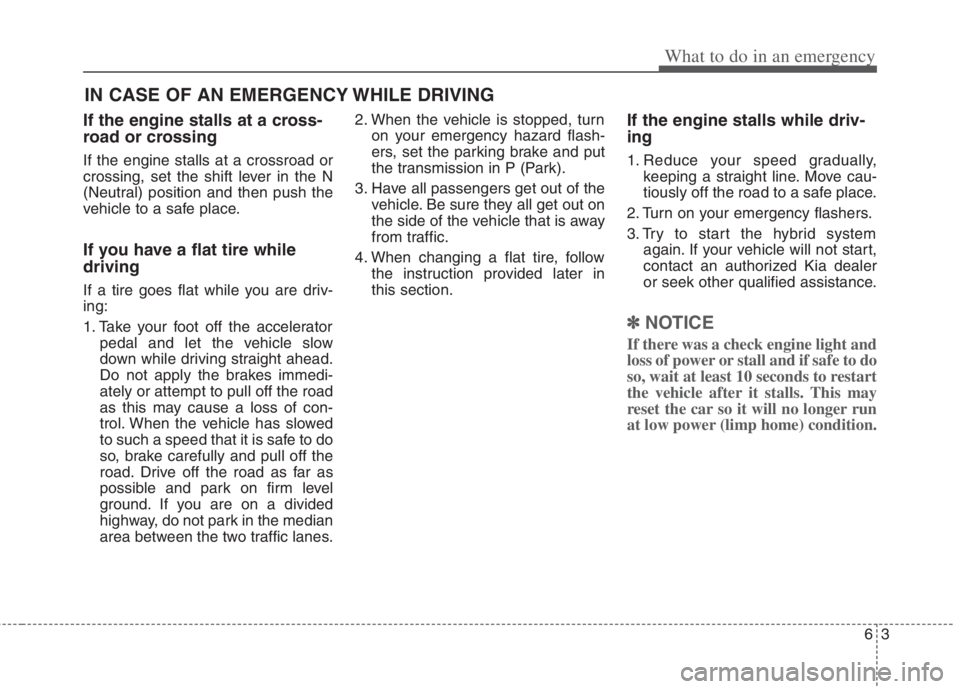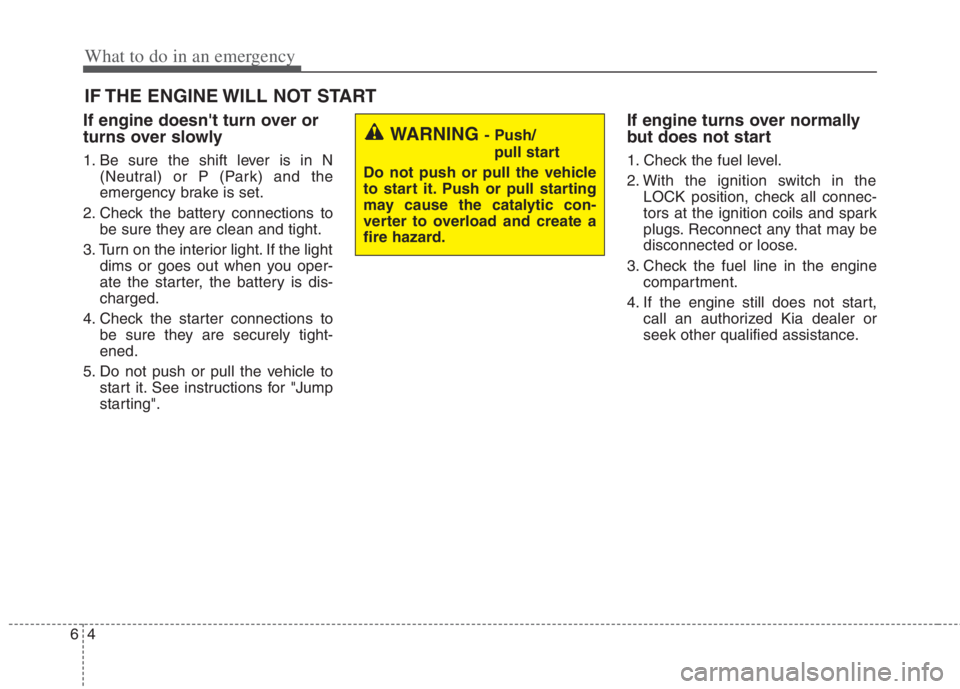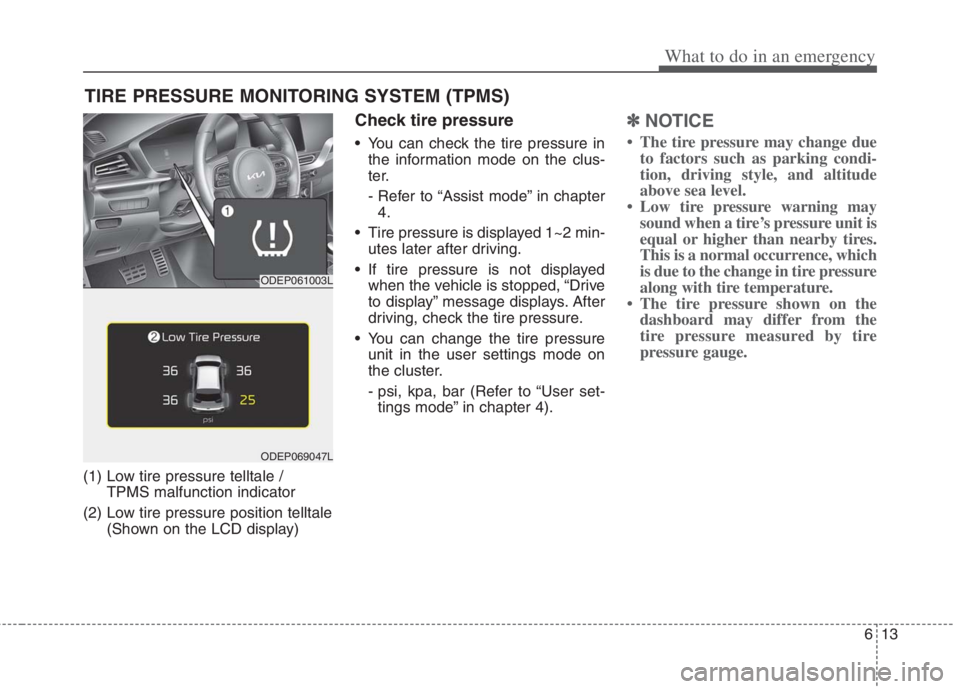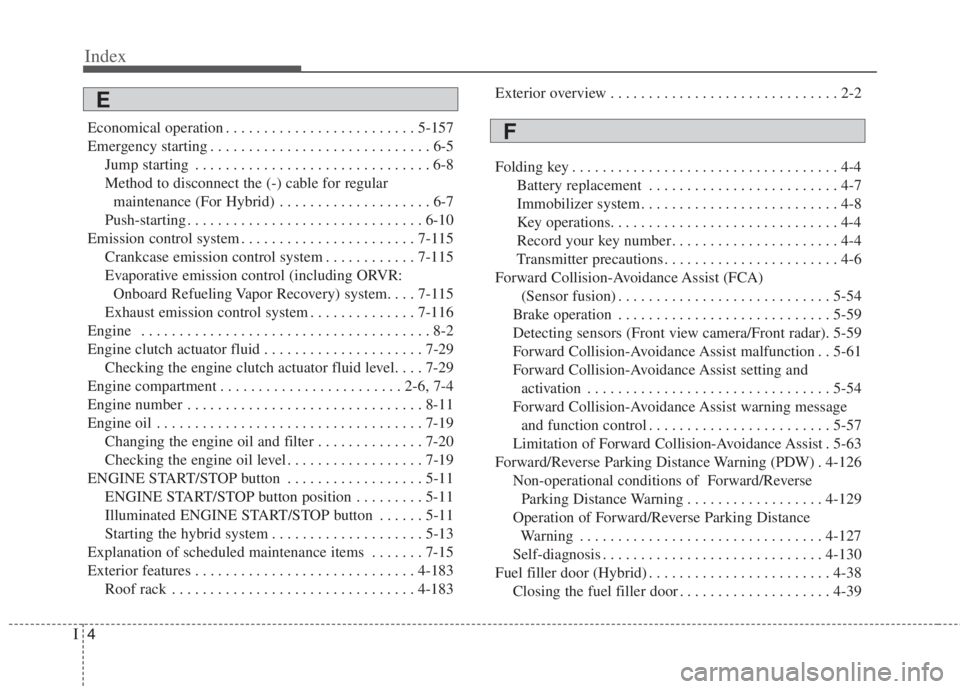2022 KIA NIRO HYBRID EV park assist
[x] Cancel search: park assistPage 501 of 684

63
What to do in an emergency
If the engine stalls at a cross-
road or crossing
If the engine stalls at a crossroad or
crossing, set the shift lever in the N
(Neutral) position and then push the
vehicle to a safe place.
If you have a flat tire while
driving
If a tire goes flat while you are driv-
ing:
1. Take your foot off the accelerator
pedal and let the vehicle slow
down while driving straight ahead.
Do not apply the brakes immedi-
ately or attempt to pull off the road
as this may cause a loss of con-
trol. When the vehicle has slowed
to such a speed that it is safe to do
so, brake carefully and pull off the
road. Drive off the road as far as
possible and park on firm level
ground. If you are on a divided
highway, do not park in the median
area between the two traffic lanes.2. When the vehicle is stopped, turn
on your emergency hazard flash-
ers, set the parking brake and put
the transmission in P (Park).
3. Have all passengers get out of the
vehicle. Be sure they all get out on
the side of the vehicle that is away
from traffic.
4. When changing a flat tire, follow
the instruction provided later in
this section.
If the engine stalls while driv-
ing
1. Reduce your speed gradually,
keeping a straight line. Move cau-
tiously off the road to a safe place.
2. Turn on your emergency flashers.
3. Try to start the hybrid system
again. If your vehicle will not start,
contact an authorized Kia dealer
or seek other qualified assistance.
✽ ✽
NOTICE
If there was a check engine light and
loss of power or stall and if safe to do
so, wait at least 10 seconds to restart
the vehicle after it stalls. This may
reset the car so it will no longer run
at low power (limp home) condition.
IN CASE OF AN EMERGENCY WHILE DRIVING
Page 502 of 684

What to do in an emergency
4 6
IF THE ENGINE WILL NOT START
If engine doesn't turn over or
turns over slowly
1. Be sure the shift lever is in N
(Neutral) or P (Park) and the
emergency brake is set.
2. Check the battery connections to
be sure they are clean and tight.
3. Turn on the interior light. If the light
dims or goes out when you oper-
ate the starter, the battery is dis-
charged.
4. Check the starter connections to
be sure they are securely tight-
ened.
5. Do not push or pull the vehicle to
start it. See instructions for "Jump
starting".
If engine turns over normally
but does not start
1. Check the fuel level.
2. With the ignition switch in the
LOCK position, check all connec-
tors at the ignition coils and spark
plugs. Reconnect any that may be
disconnected or loose.
3. Check the fuel line in the engine
compartment.
4. If the engine still does not start,
call an authorized Kia dealer or
seek other qualified assistance.
WARNING - Push/
pull start
Do not push or pull the vehicle
to start it. Push or pull starting
may cause the catalytic con-
verter to overload and create a
fire hazard.
Page 509 of 684

611
What to do in an emergency
IF THE ENGINE OVERHEATS
If your temperature gauge indicates
overheating, you will experience a
loss of power, or hear loud pinging or
knocking, the engine is probably too
hot. If this happens, you should:
1. Turn on the emergency warning
flasher and stop in a safe place.
Move the shift lever to P (Park)
and engage the parking brake.
2. If hot steam does not come out
from the engine room, carefully
open the engine room and check
whether the water pump connec-
tor is properly engaged. If the con-
nector is not properly engaged,
stop the engine immediately and
properly engage the connector.
Then, turn the engine on.
3. Turn on the air conditioner.4. If the “HEV Warning” light turns on
in the driver instrument cluster, or
engine coolant or hot steam emits
from the engine coolant filler, stop
the engine immediately. Then, call
the nearest authorized Kia dealer
for assistance. If the “Engine
Warning” light remains illuminated
or the engine coolant is not flowing
out, keep the engine running.
Open the engine hood for ventila-
tion to help cool down the engine.5. Check whether the engine coolant
temperature is low enough by
checking its temperature. If the
engine coolant level is low, please
check the connecting parts
between the radiator hose, heater
hose, and water pump for any signs
of leakage. When there is no sign of
leakage, please refill the engine
coolant. If causes and signs of
engine overheating such as warn-
ing light illumination, engine coolant
leakage, or cooling fan malfunction
are found, stop the vehicle the ear-
liest. Then, call the nearest author-
ized Kia dealer for assistance.
WARNING- Under the
Hood
While the engine is running,
keep hair, hands and clothing
away from moving parts such
as the fan and drive belts to pre-
vent injury.
WARNING- Radiator Cap
Do not remove the
radiator cap when the
engine is hot. This
can allow coolant to
blow out of the open-
ing and cause seri-
ous burns.
Page 511 of 684

613
What to do in an emergency
TIRE PRESSURE MONITORING SYSTEM (TPMS)
(1) Low tire pressure telltale /
TPMS malfunction indicator
(2) Low tire pressure position telltale
(Shown on the LCD display)
Check tire pressure
You can check the tire pressure in
the information mode on the clus-
ter.
- Refer to “Assist mode” in chapter
4.
Tire pressure is displayed 1~2 min-
utes later after driving.
If tire pressure is not displayed
when the vehicle is stopped, “Drive
to display” message displays. After
driving, check the tire pressure.
You can change the tire pressure
unit in the user settings mode on
the cluster.
- psi, kpa, bar (Refer to “User set-
tings mode” in chapter 4).
✽ ✽
NOTICE
• The tire pressure may change due
to factors such as parking condi-
tion, driving style, and altitude
above sea level.
• Low tire pressure warning may
sound when a tire’s pressure unit is
equal or higher than nearby tires.
This is a normal occurrence, which
is due to the change in tire pressure
along with tire temperature.
• The tire pressure shown on the
dashboard may differ from the
tire pressure measured by tire
pressure gauge.
ODEP061003L
ODEP069047L
Page 675 of 684

Index
2I
Air bag - advanced supplemental restraint system . . . . 3-47
Adding equipment to or modifying your air bag
-equipped vehicle . . . . . . . . . . . . . . . . . . . . . . . . . . 3-73
Air bag warning label. . . . . . . . . . . . . . . . . . . . . . . . 3-73
Air bag warning light . . . . . . . . . . . . . . . . . . . . . . . . 3-50
Curtain air bag . . . . . . . . . . . . . . . . . . . . . . . . . . . . . 3-67
Driver's and passenger's front air bag . . . . . . . . . . . 3-62
How does the air bag system operate? . . . . . . . . . . . 3-48
Occupant Detection System (ODS) . . . . . . . . . . . . . 3-54
Side air bag. . . . . . . . . . . . . . . . . . . . . . . . . . . . . . . . 3-65
SRS Care . . . . . . . . . . . . . . . . . . . . . . . . . . . . . . . . . 3-72
SRS components and functions . . . . . . . . . . . . . . . . 3-51
Air cleaner . . . . . . . . . . . . . . . . . . . . . . . . . . . . . . . . . . 7-33
Filter replacement . . . . . . . . . . . . . . . . . . . . . . . . . 7-33
Air conditioner compressor label . . . . . . . . . . . . . . . . . 8-12
Air conditioning system . . . . . . . . . . . . . . . . . . . . . . . . . 8-7
Appearance care . . . . . . . . . . . . . . . . . . . . . . . . . . . . . 7-105
Exterior care . . . . . . . . . . . . . . . . . . . . . . . . . . . . . . 7-105
Interior care . . . . . . . . . . . . . . . . . . . . . . . . . . . . . . 7-111
Automatic climate control system . . . . . . . . . . . . . . . 4-148
Automatic heating and air conditioning. . . . . . . . . 4-149
Automatic ventilation . . . . . . . . . . . . . . . . . . . . . . . 4-159
Checking the amount of air conditioner refrigerant
and compressor lubricant . . . . . . . . . . . . . . . . . . . 4-162
Climate control air filter. . . . . . . . . . . . . . . . . . . . . 4-161
Manual heating and air conditioning . . . . . . . . . . . 4-151Recirculated air at washer fluid spray . . . . . . . . . . 4-160
Sunroof inside air recirculation . . . . . . . . . . . . . . . 4-160
System operation . . . . . . . . . . . . . . . . . . . . . . . . . . 4-157
Battery (Plug-in Hybrid). . . . . . . . . . . . . . . . . . . . . . . . 7-40
For best battery service . . . . . . . . . . . . . . . . . . . . . . 7-40
Recharging the battery . . . . . . . . . . . . . . . . . . . . . . . 7-41
Reset items . . . . . . . . . . . . . . . . . . . . . . . . . . . . . . . . 7-42
Before driving . . . . . . . . . . . . . . . . . . . . . . . . . . . . . . . . . 5-5
Before entering vehicle . . . . . . . . . . . . . . . . . . . . . . . 5-5
Before starting . . . . . . . . . . . . . . . . . . . . . . . . . . . . . . 5-5
Necessary inspections . . . . . . . . . . . . . . . . . . . . . . . . 5-5
Blind-Spot Collision Warning (BCW) . . . . . . . . . . . . . 5-80
Blind-Spot Collision Warning setting and activation . 5-81
Warning message and function control . . . . . . . . . . 5-83
Brake fluid . . . . . . . . . . . . . . . . . . . . . . . . . . . . . . . . . . 7-27
Checking the brake fluid level . . . . . . . . . . . . . . . . 7-27
Brake system. . . . . . . . . . . . . . . . . . . . . . . . . . . . . . . . . 5-31
Anti-lock brake system (ABS) . . . . . . . . . . . . . . . . . 5-45
AUTO HOLD . . . . . . . . . . . . . . . . . . . . . . . . . . . . . . 5-41
Electronic Parking Brake (EPB) . . . . . . . . . . . . . . . 5-35
Electronic Stability Control (ESC) . . . . . . . . . . . . . 5-47
Good braking practices . . . . . . . . . . . . . . . . . . . . . . 5-53
Hill-start Assist Control (HAC) . . . . . . . . . . . . . . . . 5-52
Parking brake – Foot type . . . . . . . . . . . . . . . . . . . . 5-33
Power brakes . . . . . . . . . . . . . . . . . . . . . . . . . . . . . . 5-31
A
B
Page 677 of 684

Index
4I
Economical operation . . . . . . . . . . . . . . . . . . . . . . . . . 5-157
Emergency starting . . . . . . . . . . . . . . . . . . . . . . . . . . . . . 6-5
Jump starting . . . . . . . . . . . . . . . . . . . . . . . . . . . . . . . 6-8
Method to disconnect the (-) cable for regular
maintenance (For Hybrid) . . . . . . . . . . . . . . . . . . . . 6-7
Push-starting . . . . . . . . . . . . . . . . . . . . . . . . . . . . . . . 6-10
Emission control system . . . . . . . . . . . . . . . . . . . . . . . 7-115
Crankcase emission control system . . . . . . . . . . . . 7-115
Evaporative emission control (including ORVR:
Onboard Refueling Vapor Recovery) system. . . . 7-115
Exhaust emission control system . . . . . . . . . . . . . . 7-116
Engine . . . . . . . . . . . . . . . . . . . . . . . . . . . . . . . . . . . . . . 8-2
Engine clutch actuator fluid . . . . . . . . . . . . . . . . . . . . . 7-29
Checking the engine clutch actuator fluid level. . . . 7-29
Engine compartment . . . . . . . . . . . . . . . . . . . . . . . . 2-6, 7-4
Engine number . . . . . . . . . . . . . . . . . . . . . . . . . . . . . . . 8-11
Engine oil . . . . . . . . . . . . . . . . . . . . . . . . . . . . . . . . . . . 7-19
Changing the engine oil and filter . . . . . . . . . . . . . . 7-20
Checking the engine oil level . . . . . . . . . . . . . . . . . . 7-19
ENGINE START/STOP button . . . . . . . . . . . . . . . . . . 5-11
ENGINE START/STOP button position . . . . . . . . . 5-11
Illuminated ENGINE START/STOP button . . . . . . 5-11
Starting the hybrid system . . . . . . . . . . . . . . . . . . . . 5-13
Explanation of scheduled maintenance items . . . . . . . 7-15
Exterior features . . . . . . . . . . . . . . . . . . . . . . . . . . . . . 4-183
Roof rack . . . . . . . . . . . . . . . . . . . . . . . . . . . . . . . . 4-183Exterior overview . . . . . . . . . . . . . . . . . . . . . . . . . . . . . . 2-2
Folding key . . . . . . . . . . . . . . . . . . . . . . . . . . . . . . . . . . . 4-4
Battery replacement . . . . . . . . . . . . . . . . . . . . . . . . . 4-7
Immobilizer system . . . . . . . . . . . . . . . . . . . . . . . . . . 4-8
Key operations. . . . . . . . . . . . . . . . . . . . . . . . . . . . . . 4-4
Record your key number . . . . . . . . . . . . . . . . . . . . . . 4-4
Transmitter precautions . . . . . . . . . . . . . . . . . . . . . . . 4-6
Forward Collision-Avoidance Assist (FCA)
(Sensor fusion) . . . . . . . . . . . . . . . . . . . . . . . . . . . . 5-54
Brake operation . . . . . . . . . . . . . . . . . . . . . . . . . . . . 5-59
Detecting sensors (Front view camera/Front radar). 5-59
Forward Collision-Avoidance Assist malfunction . . 5-61
Forward Collision-Avoidance Assist setting and
activation . . . . . . . . . . . . . . . . . . . . . . . . . . . . . . . . 5-54
Forward Collision-Avoidance Assist warning message
and function control . . . . . . . . . . . . . . . . . . . . . . . . 5-57
Limitation of Forward Collision-Avoidance Assist . 5-63
Forward/Reverse Parking Distance Warning (PDW) . 4-126
Non-operational conditions of Forward/Reverse
Parking Distance Warning . . . . . . . . . . . . . . . . . . 4-129
Operation of Forward/Reverse Parking Distance
Warning . . . . . . . . . . . . . . . . . . . . . . . . . . . . . . . . 4-127
Self-diagnosis . . . . . . . . . . . . . . . . . . . . . . . . . . . . . 4-130
Fuel filler door (Hybrid) . . . . . . . . . . . . . . . . . . . . . . . . 4-38
Closing the fuel filler door . . . . . . . . . . . . . . . . . . . . 4-39F
E